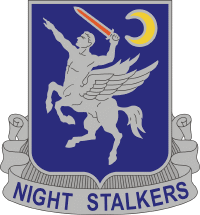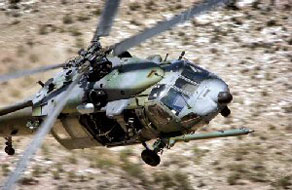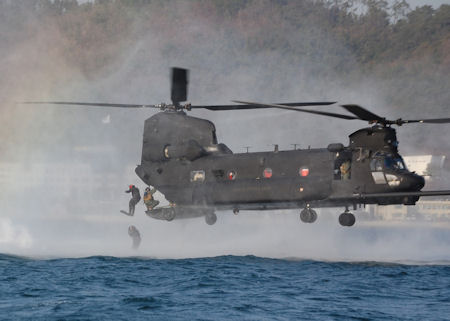160th Special Operations Aviation Regiment (Airborne)
Based out of Fort Campbell, Kentucky, the 160th Special Operations Aviation Regiment (Airborne) is part of the US Army Special Operations Command (USASOC). This renowned aviation unit is home to the Army’s most elite helicopter pilots. Known as the “Night Stalkers” for their skills flying with night-vision and infrared devices, the pilots and crews of this elite unit excel in navigating through enemy territory, at very low altitude flying “nap-of-the-earth” and often in foul weather.
The Night Stalkers hide under the cover of darkness in order to avoid being detected by the enemy. Using the latest night-vision technology and tactics that allow them to fly low-level, the 160th SOAR specializes in delivering special operations forces safely into some of the most dangerous places in the world, whether in an enemy’s backyard or a high altitude mountain hideout. They are experts at executing high-risk, low level reconnaissance, attack and air assault missions.
 This capability wasn’t available at the time of the Operation EAGLE CLAW – the Iranian hostage rescue attempt in 1980. As a result of that failed attempt, the Holloway Commission, chaired by the former Chief of Naval Operations Admiral James L. Holloway, mandated a re-organization of the nation’s special operations capabilities, placed emphasis on interoperability, and focused on establishing a dedicated Special Operations Aviation force. The Department of Defense realized it needed an elite helicopter unit capable of carrying out short notice, infiltration special operations missions.
This capability wasn’t available at the time of the Operation EAGLE CLAW – the Iranian hostage rescue attempt in 1980. As a result of that failed attempt, the Holloway Commission, chaired by the former Chief of Naval Operations Admiral James L. Holloway, mandated a re-organization of the nation’s special operations capabilities, placed emphasis on interoperability, and focused on establishing a dedicated Special Operations Aviation force. The Department of Defense realized it needed an elite helicopter unit capable of carrying out short notice, infiltration special operations missions.
The Army selected aviators and support personnel from the 101st Airborne Division which, at the time, had most diverse mix of operational experience. These chosen elements began extensive training geared towards a second rescue attempt. This mission was canceled when the hostages were released in January 1981. The unit was not disbanded because its capabilities were determined to be too valuable to lose. The unit was detached from the 101st and re-designated the 160th Aviation Battalion on October 16, 1981. In 1986, the unit was re-designated as the 160th Aviation Group (Airborne). The modern day 160th Special Operations Aviation Regiment (Airborne) was officially activated in June 1990.
Operational History of the 160th SOAR
 Since that time, the unit has grown in size and participated in numerous combat related engagements. The unit participated in the invasion of Grenada in 1983 and, to increase its capability, became an aviation group with the addition of three battalions and other assets. During 1987 and 1988, the Night Stalkers flew in support of the mission to protect re-flagged Kuwaiti oil tankers in the Persian Gulf. The 160th was the spearhead of the U.S. invasion of Panama in 1989 and participated in Operation Desert Storm in 1991. One of the Night Stalkers’ most infamous actions was the October 1993 Battle of Mogadishu. This engagement resulted in the downing of two MH-60 Blackhawks and became the subject of the book and film entitled Blackhawk Down. They also played a role in the rescue of Pvt. Jessica Lynch. Today, the regiment is flying special operations missions in Afghanistan. They initially flew in support of the Northern Alliance in the overthrow of the Taliban. The 160th flew missions supporting U.S. and British Special Forces during the Tora Bora operation to capture Osama Bin Laden. They continue to fly in support of Delta, Navy SEAL and CIA missions against Taliban insurgents. Their latest mission was the flight from Afghanistan into Pakistan in support of the raid that captured and killed Bin Laden on May 1, 2011.
Since that time, the unit has grown in size and participated in numerous combat related engagements. The unit participated in the invasion of Grenada in 1983 and, to increase its capability, became an aviation group with the addition of three battalions and other assets. During 1987 and 1988, the Night Stalkers flew in support of the mission to protect re-flagged Kuwaiti oil tankers in the Persian Gulf. The 160th was the spearhead of the U.S. invasion of Panama in 1989 and participated in Operation Desert Storm in 1991. One of the Night Stalkers’ most infamous actions was the October 1993 Battle of Mogadishu. This engagement resulted in the downing of two MH-60 Blackhawks and became the subject of the book and film entitled Blackhawk Down. They also played a role in the rescue of Pvt. Jessica Lynch. Today, the regiment is flying special operations missions in Afghanistan. They initially flew in support of the Northern Alliance in the overthrow of the Taliban. The 160th flew missions supporting U.S. and British Special Forces during the Tora Bora operation to capture Osama Bin Laden. They continue to fly in support of Delta, Navy SEAL and CIA missions against Taliban insurgents. Their latest mission was the flight from Afghanistan into Pakistan in support of the raid that captured and killed Bin Laden on May 1, 2011.
Because special operations usually require specialized equipment, the Night Stalkers fly modified versions of U.S. Army helicopters. These aircraft are the MH-47G Chinook, the MH-60M Black Hawk and the MH/AH-6M Little Bird. These helicopters have in-flight refueling capabilities, advanced electronics packages, fast rope insertion rappelling systems and increased fuel capacity. The MH-60M and MH/AH-6M have weapon system capabilities not found in regular aviation units. Some of their aircraft such as the MH-60 DAPs (Direct Action Penetrator) and MH-6 are brimming with guns and rockets mounted on hard points under the wing stubs. Their firepower is a game-changer on the battlefield and the ability for SOF ground forces to have dedicated Special Operations Aviation Close Air Support (CAS) is invaluable. As demonstrated by pictures of the recent raid to capture Bin Laden, the aircraft of the 160th have stealth characteristics as well.
The 160th SOAR is comprised of a headquarters company, a special operations training company and four aviation battalions. The majority of the regimental assets are stationed at Ft. Campbell, KY. There is one operations battalion located at Ft Stewart, GA and another at Ft. Lewis, WA.
The SOAR has served in almost every U.S. conflict around the world, conducting critical missions, sensitive in nature, and often classified. Missions include airborne command and control, resupplying special operations units, search and rescue, escape and evasion activities, direct action, infil/exfil, quick reaction force, and fire support.
The officer corps of the regiment is made up entirely of volunteers. The enlisted cadres are volunteers or have been assigned to the unit by the U.S. Army. Upon arrival with the regiment, soldiers receive and are required to pass an intensive training program called the Green Platoon course. This initial entry course lasts five weeks for enlisted soldiers and between 20 to 28 weeks for officers. When the new arrival joins their operational unit they are considered Basic Mission Qualified. To become Fully Mission Qualified, the individual soldier must pass a series of test qualifications, gain the requisite experience and demonstrate superior leadership characteristics. After another three to five years, the Night Stalker is eligible to be considered for the designation of flight leader. Because of the nature of its mission, the 160th recruits women only for staff positions. The result of this training is that the 160th SOAR has the U.S. Army’s best-qualified aviators and support soldiers who are more than capable of carrying out the most demanding special operations and living up to the unit motto – “Night Stalkers Don’t Quit.”
MH-47G Chinook
 THE MH-47 Chinook helicopter is the 160th Special Operations Aviation Regiment’s long-distance, heavy-lift helicopter which conducts overt and clandestine infiltration, exfiltration, air assault, resupply and sling-load operations over a wide range of environmental conditions. The aircraft can perform a variety of other missions including shipboard, platform, urban, water, parachute, forward arming and refueling point (FARP), mass casualty, and combat search and rescue.
THE MH-47 Chinook helicopter is the 160th Special Operations Aviation Regiment’s long-distance, heavy-lift helicopter which conducts overt and clandestine infiltration, exfiltration, air assault, resupply and sling-load operations over a wide range of environmental conditions. The aircraft can perform a variety of other missions including shipboard, platform, urban, water, parachute, forward arming and refueling point (FARP), mass casualty, and combat search and rescue.
Using special mission equipment and night vision devices, MH-47 aircrews can operate in hostile mission environments over all types of terrain at low altitudes during periods of low visibility and low ambient lighting conditions with pinpoint navigation accuracy.
Based on operational experience in Afghanistan, the MH-47 was found to be an effective substitute for the MH-60 Black Hawk as an assault helicopter. With its larger payload, range, and higher operating speed, one Chinook can replace up to five MH-60s in this role as an air assault transport.
- Crew: 3; pilot, co-pilot and flight engineer
- Capacity: 33-55 troops or 28,000 pounds of cargo
- Length: 98.8 ft.
- Height: 9.8 ft.
- Rotor diameter: 60 ft.
- Maximum speed: 170 knots
- Cruise speed: 130 knots
- Range: 400 nautical miles
- Service ceiling: 18,500 ft.
- Rate of climb: 1,522 ft./min.
Check out our new section on Air Force Special Operations.
MH-60L DAPs
special operations forces on the ground need close air support, they call upon the 160th SOAR’s MH-60L DAPs (Direct Action Penetrator). This Blackhawk variant has game-changing weapon system capabilities. The MH-60L does not carry troops. Its primary mission is armed escort of infiltration and exfiltration missions conducted by MH-47Gs and MH-60Ks. The aircraft’s external stub wings have been modified to mount 7.62mm mini guns or 30mm cannon, 2.75 inch aerial rocket pods and precision guided munitions such as the Hellfire missile. The DAP acts as an attack helicopter providing area suppression or pin point attacks due to its laser designator. With its onboard advanced avionics packages, the MH-60L is capable of operations during daylight, at night and under adverse weather conditions. The MH-60L is often referred to as the “AH-60L” because it can engage targets with the same Hellfire missile and 30mm cannon found on the AH-64 Apache. The DAP provides dedicated close air support to US military special operations forces, CIA country teams and other agencies conducting operations in Afghanistan just as the Apache does for conventional ground forces.
Special operations usually require aircraft with special capabilities. These three highly advanced helicopters give the 160th SOAR the ability to support ongoing, often clandestine, missions in Afghanistan.
Special Ops Gear
Lone Survivor
 Four US Navy SEALS departed one clear night in early July, 2005 for the mountainous Afghanistan-Pakistan border for a reconnaissance mission. Their task was to document the activity of an al Qaeda leader rumored to have a small army in a Taliban stronghold. Five days later, only one of those Navy SEALS made it out alive.
Four US Navy SEALS departed one clear night in early July, 2005 for the mountainous Afghanistan-Pakistan border for a reconnaissance mission. Their task was to document the activity of an al Qaeda leader rumored to have a small army in a Taliban stronghold. Five days later, only one of those Navy SEALS made it out alive.
This is the story of the only survivor of Operation Redwing, US Navy SEAL Petty Officer Marcus Luttrell, and the extraordinary firefight that led to the largest loss of life in American Navy SEAL history. Lt. Michael P. Murphy led the team of PO2 Luttrell, PO2 Dietz and PO2 Axelso. Luttrell fought valiantly beside his teammates until he was the only one left alive, blasted by an RPG into a place where his pursuers could not find him. Over the next four days, terribly injured and presumed dead, Luttrell crawled for miles through the mountains and was taken in by sympathetic villagers who risked their lives to keep him safe from surrounding Taliban warriors.
Masters of Chaos
 The wars in Afghanistan and Iraq have given the U.S. Army’s Special Forces, also known as the Green Berets, a central role in American military action like never before. Several hundred U.S. Special Forces operators helped a motley band of Afghan rebels orchestrate a stunning rout when they overthrew the Taliban after 9/11. In Iraq, as journalist Linda Robinson explains in Masters of Chaos: The Secret History of the Special Forces, Special Forces units were the main U.S. elements on the ground in the northern and western regions of the country, where they defeated government forces that outnumbered them many times over. Robinson tells the story of the Special Forces through the eyes of a few of its more colorful personalities, men with call signs like Rawhide and Killer. She follows them around the world from Panama and El Salvador to Somalia, Kosovo, and, finally, Afghanistan and Iraq. Surprisingly, however, she devotes only a few pages to the Green Beret-led victory in Afghanistan, even though it was arguably their greatest achievement since they were created after World War II.
The wars in Afghanistan and Iraq have given the U.S. Army’s Special Forces, also known as the Green Berets, a central role in American military action like never before. Several hundred U.S. Special Forces operators helped a motley band of Afghan rebels orchestrate a stunning rout when they overthrew the Taliban after 9/11. In Iraq, as journalist Linda Robinson explains in Masters of Chaos: The Secret History of the Special Forces, Special Forces units were the main U.S. elements on the ground in the northern and western regions of the country, where they defeated government forces that outnumbered them many times over. Robinson tells the story of the Special Forces through the eyes of a few of its more colorful personalities, men with call signs like Rawhide and Killer. She follows them around the world from Panama and El Salvador to Somalia, Kosovo, and, finally, Afghanistan and Iraq. Surprisingly, however, she devotes only a few pages to the Green Beret-led victory in Afghanistan, even though it was arguably their greatest achievement since they were created after World War II.
Special Operations in Iraq
 This sensational book reveals the true and compelling story of the Special Force units of the Coalition, such as the SAS, SBS and Delta Force who worked in the shadows, often unseen, unheard and unsung. It describes their missions behind the lines from the early days, well before hostilities opened formally. It was an open secret that groups were deployed probably operating in the western desert against Saddam’s forces and the Scud missile threat. What was actually going on is revealed here and until now their roles and actions have not been described in any detail.
This sensational book reveals the true and compelling story of the Special Force units of the Coalition, such as the SAS, SBS and Delta Force who worked in the shadows, often unseen, unheard and unsung. It describes their missions behind the lines from the early days, well before hostilities opened formally. It was an open secret that groups were deployed probably operating in the western desert against Saddam’s forces and the Scud missile threat. What was actually going on is revealed here and until now their roles and actions have not been described in any detail.
These are thrilling tales of incredible daring and endurance told by men whose courage and military skills are inspiring. The book also covers operations such as the spectacular rescue of POW Private Lynch and the secret operations to target Saddam and other leaders of his regime of terror.
Among Warriors in Iraq
 Join Big Hungry, Kentucky Rife, Serpico and Jedi Knight for a harrowing journey into the heart of the Iraqi insurgency. A former Marine infantryman, Tucker follows the warriors of the 101st Airborne Division in Mosul and the 82nd Airborne and 10th Mountain Divisions in Fallujah during 19 weeks of urban warfare in late 2003 and early 2004. In declaratives one might describe as debased Hemingway on speed, Tucker tags along for counter-IED (improvised explosive devices) patrols and zero-dark-30 (predawn) raids, capturing the adrenaline-laced urgency of urban combat against a hidden enemy. His conversations with troopers are refreshingly authentic; his analysis of the politics of Iraq tends toward open advocacy for the Kurds and a separate state of Kurdistan. (Tucker is the author of Hell Is Over: Voices of the Kurds After Saddam.) But his gritty firsthand account is packed with detail: from the slow ballet of “scoping roof tops and alley corners,” the excruciating tension of disarming IEDs and the frenetic choreography of urban combat to the children who are never far away and are always quick with a smile, a wave and an enthusiastic “Amerikee!” Several impressive accounts of the second Iraq War have appeared already from embedded journalists, but few are as personal and edgy as Tucker’s.
Join Big Hungry, Kentucky Rife, Serpico and Jedi Knight for a harrowing journey into the heart of the Iraqi insurgency. A former Marine infantryman, Tucker follows the warriors of the 101st Airborne Division in Mosul and the 82nd Airborne and 10th Mountain Divisions in Fallujah during 19 weeks of urban warfare in late 2003 and early 2004. In declaratives one might describe as debased Hemingway on speed, Tucker tags along for counter-IED (improvised explosive devices) patrols and zero-dark-30 (predawn) raids, capturing the adrenaline-laced urgency of urban combat against a hidden enemy. His conversations with troopers are refreshingly authentic; his analysis of the politics of Iraq tends toward open advocacy for the Kurds and a separate state of Kurdistan. (Tucker is the author of Hell Is Over: Voices of the Kurds After Saddam.) But his gritty firsthand account is packed with detail: from the slow ballet of “scoping roof tops and alley corners,” the excruciating tension of disarming IEDs and the frenetic choreography of urban combat to the children who are never far away and are always quick with a smile, a wave and an enthusiastic “Amerikee!” Several impressive accounts of the second Iraq War have appeared already from embedded journalists, but few are as personal and edgy as Tucker’s.


















